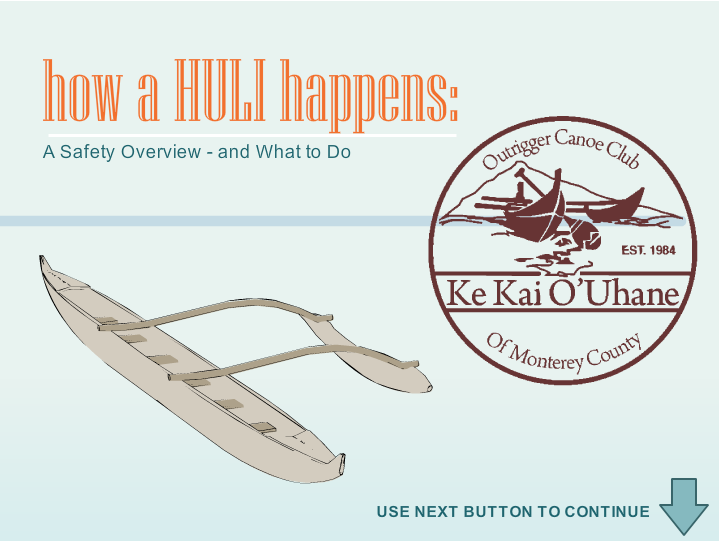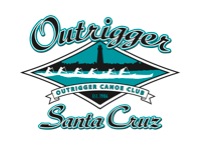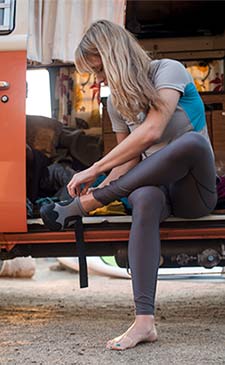Safety Manual
The complete safety manual can be found here -> Safety Manual and in the shed.
Basic Safety Procedures
- Every paddler must have a PFD in the canoe. Wear the PFD if you feel it necessary or can not tread water for 30 minutes. Children under 13 MUST wear a PFD at all times.
- Every OC6 must have two bailers and a drybag safety kit with a VHF radio secured in the canoe
- The steersperson is ultimately responsible for evaluating the conditions and setting an appropriate course.
Crew members may express concerns if they’re uncomfortable with the conditions, which the steersperson will take under advisement.
- Always be dressed for immersion in cold water (see below).
- Understand your seat’s responsibilities in the event of a huli (see below).
- Be aware of, and be prepared for, existing conditions. These include: wind speed and direction, swell size and direction, tide changes, air temperature, and water temperature.
- Be aware of your approximate location
- Secure all loose objects in strapped-in mesh bags or dry bags.
- Bring water and a snack when going on a long paddle (especially anything over 90 minutes).
Check conditions here:
National Weather Service Marine Zone Santa Cruz
Any of our VHF radios – press the WX button
Check buoy locations here:
Avoid Hypothermia
Some Facts About Hypothermia
If you’re immersed in water that’s 50 degrees F. (which is typical in Monterey Bay in winter), you’re likely to die within one-and-a-half hours (usually from heart failure). Exhaustion and unconsciousness will occur within 30-to-60 minutes, making it harder to keep yourself from being immersed longer. You can get hypothermic without even getting wet. Winter temperatures of 45 degrees F., with 20-mph winds, are not uncommon on the Monterey Bay in the winter, and these conditions can lead to hypothermia.
Preventing Hypothermia
- Don’t go out if it is too cold! Here the air temp can be deceivingly warm when the water is too cold. A good rule of thumb is don’t paddle unless air temp + water temp > 110
- Don’t capsize! Paddle very safely in cold conditions. Don’t paddle in conditions above your crew’s ability level.
- Wear no cotton! Wen wet, it stops being an insulator, and instead becomes a heat conductor.
- Layer with fleece, neoprene, nylon, and other synthetics. Wool is fine, but synthetics are lighter, warmer, and retain less water. Even if you wear a wetsuit, carry a water-and-windproof outer layer. Once you right your canoe, your wetsuit will stay wet and cause evaporative cooling. An outer layer will help prevent evaporative cooling.
- Wear a wool or similar synthetic hat. Once you’re clothed properly, 80-90% of your heat loss will be through your head.
- Wear neoprene booties, especially in an OC1 or OC2.
Symptoms of Hypothermia
- Mild hypothermia: Uncontrolled, intense shivering. Movements becomes less coordinated. Some pain and discomfort.
- Moderate hypothermia: Shivering slows or stops. Muscles begin to stiffen. Metal confusion and apathy sets in. Speech becomes slow, vague, and slurred. Breathing becomes slower and shallow.
- Severe hypothermia: Skin is cold, may be bluish-gray. Eyes may be dilated. Very weak. Marked lack of coordination. Slurred speech. Exhaustion. Denies problem and may resist help. Gradual loss of consciousness. May become very rigid, unconscious, and appear dead.
Huli Recovery Procedure
Here is an excellent video from our fellow club Ke Kai OʻUhane of Monterey.

- Seat 6 calls out each seat number in order 1 through 5. Each paddler responds with “OK”.
- Everyone quickly puts their paddles under their seats (between the seats and the bottom of the capsized canoe)
- Everyone stays on the ama side of the canoe (instead of swimming under the canoe to the non-ama side)
- Seats 1 from bow and seat 6 from stern orient the canoe facing into the swell.
- Seats 3 & 4 step onto the upside down iako, climb onto the hull, turn and step on the stubs of the iako, grab the ama side iako and right the canoe when seat six says “ready, LIFT”.
- Seats 2 & 5 can help lift the ama as 3 & 4 right it if necessary.
- Seats 3 & 4 slow the ama as it drops into the water.
- Seats 3 & 4 then use the iakos of the righted canoe to pull themselves partly out of the water and to weight the left side of the canoe for seats 2 & 5 to get in.
- Seats 2 & 5 jump into the canoe from the right side of the canoe and bail like crazy towards the ama side.
- When seat six says “3 and 4 IN” seats 3 & 4 jump in and assist bailing with 2 & 5.
- When seat six says “everyone IN” seats 1 & 6 jump in from ama side.
- While 3 & 4 finish bailing, the rest paddle to keep the canoe from swamping.
Notes on Huli Recovery

Often times it happens before you know it and you find yourself in the water. The cold water can stun and disorient you. Surface with your arm above your head to avoid hitting it on the ama. Keep calm and remember your training!
Stay with your canoe: right it and get back in, or stay on top of your over-turned canoe until you can be rescued. If you are unable to right the canoe or it is damaged beyond use Use The Radio and call for help on channel 16. Don’t delay, the hypothermia clock has begun. Put on the PFDs.
Bail quickly with fast short bails, also use the 5 gallon bucket.

